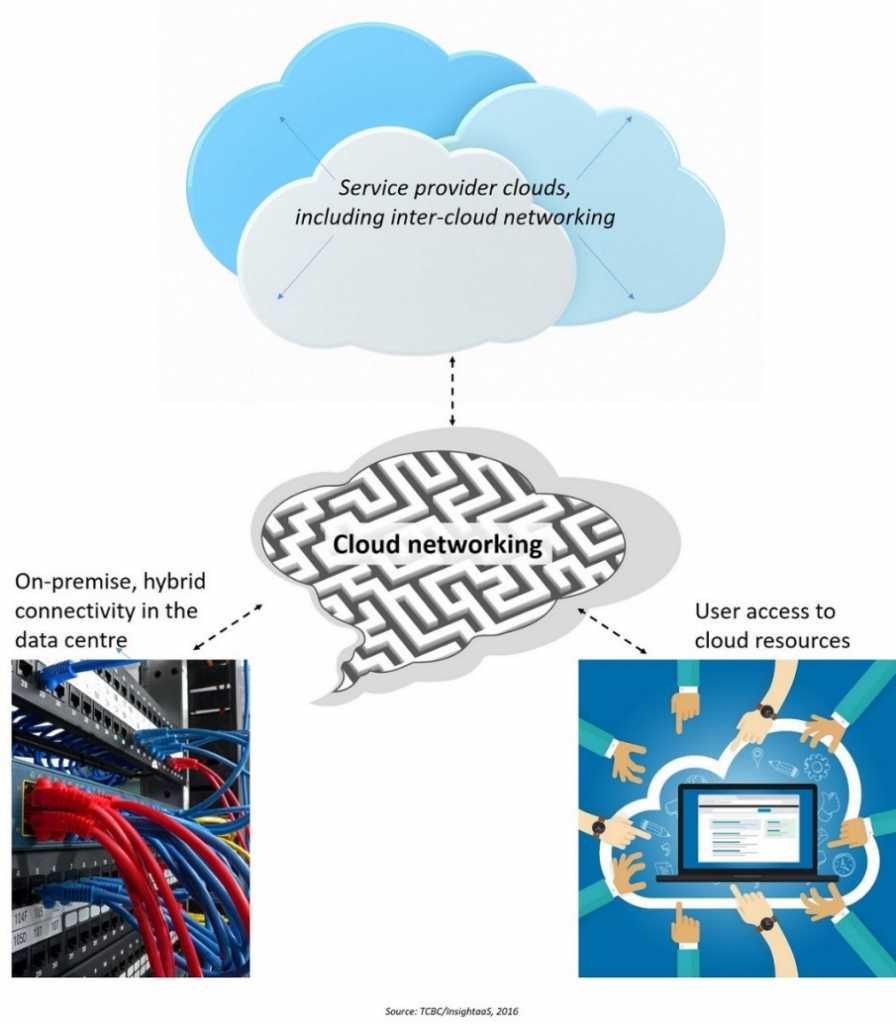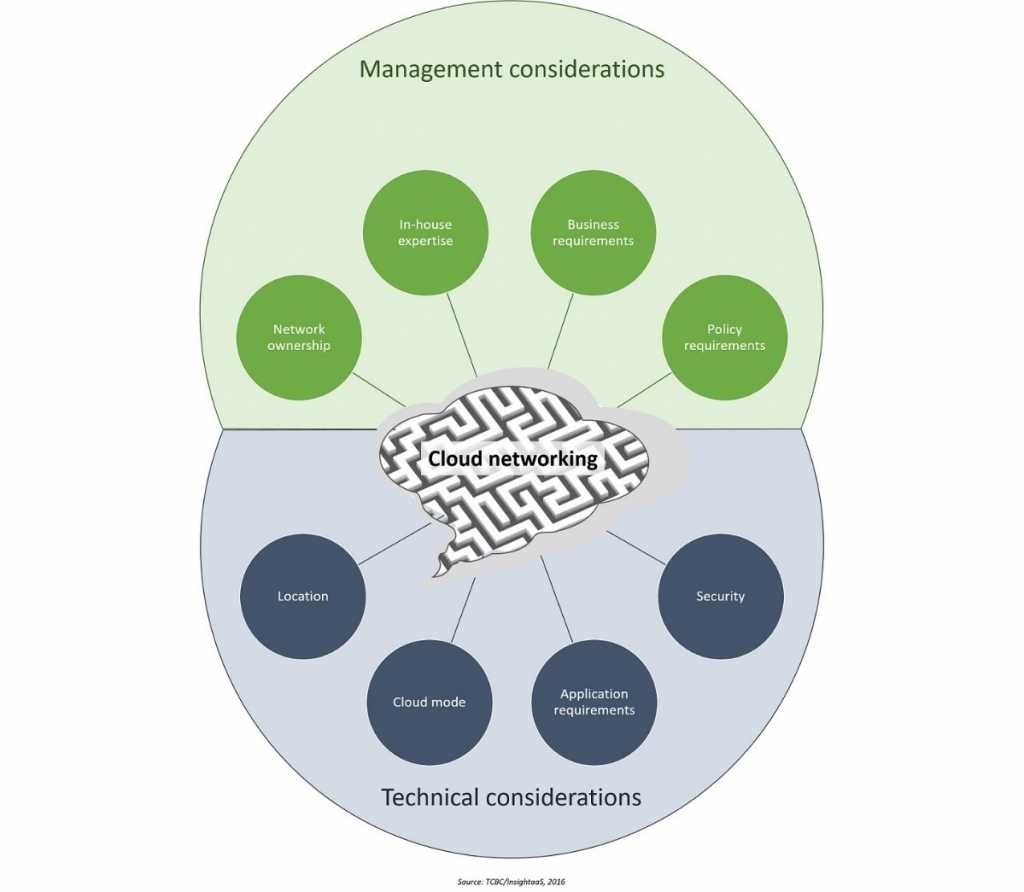The notion that “a cloud is only as good as the network it connects to” has inspired development of the Toronto Cloud Business Coalition’s latest publication, On Ramps to Cloud – the Network. Combining insight from IT professional across the spectrum of Canada’s networking industry, the new report wraps this expert input into best practices guidance for organizations that are looking to optimize access to cloud resources through the creation of secure, modern communications that can match the speed, efficiency and flexibility of cloud technologies.
Cloud communications are complex: spanning public and private cloud as well as hybrid IT environments, cloud networking encompasses the deployment of multiple technologies, including data centre networking, broadband, and access networks such as WIFi, which are used to link resources in three different scenarios. As figure (below) from the report shows, the TCBC On Ramps working group has considered networking needs from the perspectives of: on-premise cloud, user access to cloud resources and inter-cloud communications.

Cloud networking represents an evolving requirement – adopters will transition from migration to cloud in ad hoc pilots to wide spread use of the technology across the organization, and with these shifts, supporting network requirements will also change. To ensure that networking is aligned with cloud adoption stages – and business needs and internal resources – the working group advises that adopting organizations begin with an assessment that addresses both technical and management considerations, as follows:
Technical criteria:
- New security requirements will determine the best network topology for the cloud implementation as the organization transitions from traditional perimeter defense tactics such as firewalls to new security architectures that protect data at rest and in transit.
- Proximity of customer data and cloud services is a key consideration in building cloud networks. Location can impact network latency, speed and performance.
- Applications have different networking requirements. Voice, video or other communications applications, for example, will require more bandwidth than productivity apps.
- Cloud environments (public, private or hybrid) that will be connected to on-premise or cloud provider services may have different integration requirements.
Management criteria:
- Responsibility for network provisioning must be defined in provider relationships. Customer control of the networking stack vs. provider ownership may vary depending on the size of the organization, the technology involved and access to capabilities.
- Organizations have different cloud network models to choose from: Cloud-Enabled Networking (CEN), where management and control over policy definition are placed in cloud and connectivity and packet-mode functions, such as routing, switching and security, remain local and hardware-based, vs. Cloud-Based Networking, or Network-as-a-Service, where all core networking functions move to the cloud.
- Cloud user needs should be defined, as traffic patterns will differ based on the consumer, and on the mix of public cloud, private cloud and on-premise infrastructure needed to support users’ applications. Deployment of classic LAN expanders, such as VPN, for example, is a practical approach, but must address differences between traffic patterns in on-premise and cloud infrastructure.
- Network readiness assessment that identifies security parameters for the data will determine the need (or not) for over-the-top, private communications lines.
- Availability of in-house cloud networking competencies.
- Policy decisions around network access. Cloud data may be accessed via the public Internet, private networks or a tiered topology that spans both; network access should be designed according to data governance and security requirements.
 On Ramps to Cloud explores each of these criteria in some detail, with an eye to helping cloud adopters better understand what networking options are available and best suited to current needs. The report also tackles more mature opportunities for optimizing cloud networks, including the deployment of security technologies such as encryption for data at rest and in motion, single sign on to improve user experience, the potential to broker cloud communications, as well as the use of advanced networking technologies, including SDN and NFV.
On Ramps to Cloud explores each of these criteria in some detail, with an eye to helping cloud adopters better understand what networking options are available and best suited to current needs. The report also tackles more mature opportunities for optimizing cloud networks, including the deployment of security technologies such as encryption for data at rest and in motion, single sign on to improve user experience, the potential to broker cloud communications, as well as the use of advanced networking technologies, including SDN and NFV.
A key piece in the document – as is the case with each TCBC best practices report – is a concluding section on “Metrics and Milestones” that identifies KPIs and other indicators that may be used to track progress towards the establishment of modern networking which can support the organization’s cloud goals. According to the working group, many of the traditional metrics that network administrators have used are subsumed in cloud provider relationships, where success is boiled down to uptime and performance as guaranteed in service provider SLAs, which can be monitored internally or with use of third-party, online tools and services. That said, there are additional metrics that become increasingly important for application service delivery in a multi-cloud world: link latency and round-trip times can will identify traffic bottlenecks in specific pathways in service provider networks, measures of available network capacity can enable prioritization of certain traffic or applications; and monitoring of bandwidth consumption, which is likely to vary directly with the use of cloud services, can help the organization better manage costs and service reliability.
Sponsors and working group
Creation of TCBC reports is underwritten by the community’s corporate and individual sponsors. Corporate sponsors include CenturyLink, Cisco, Cogeco Peer 1, CloudOps, Information Builders, Ingram Micro, Avaya, Schneider Electric, Dimensional Strategies Inc., Twelvedot and ProServe IT.
InsightaaS and the TCBC would like to recognize the working group members whose insight and expertise are the source of On Ramps to Cloud’s exceptional depth and quality (note – links require that you are logged into LinkedIn):
Ian Rae, CloudOps
Don Sheppard, ConCon Management Services
Jeff Cohen, Yum! Brands Canada
Scott Metcalfe, Jones Lang LaSalle
Celia Crowshaw, Cogeco Peer 1
The report also benefits from expert contributions from:
Joe Belinsky, Moneris Solutions
Andrew Eppich, Equinix Canada
Ian Locke, transformation technology expert
Brian Ochab, CSB practice leader
Tracey Hutchison, Cisco Systems
Norman Sung, Red Hat
Obtaining access to the report
On Ramps to Cloud – the Network is available to community members in the TCBC Best Practices library, and distributed through member networks. The report is also available from InsightaaS. For your copy, and for more information on the TCBC, its sister communities (IoT Coalition Canada, Canadian Analytics Business Coalition, and Vision2Value (V2V): The Economics of Data) and our ongoing publication of best in class best practices guidance on the deployment of transformative technologies in Canada, please follow this link, and use the code ONRAMPS-2.








